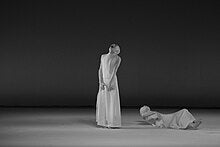
Butoh
Share
Butoh is a dance born in Japan in the 1960s. This "dance of the dark body" breaks with the traditional live arts of noh and kabuki, which seem powerless to express new issues.
Butoh was born not to evacuate the suffering caused by the tragic events of Hiroshima and Nagasaki in 1945[ref. needed], as has often been said, but from the socio-political turmoil that shook Japan at that time.
Butoh was founded by Tatsumi Hijikata (1928-1986), with whom Kazuo Ōno (1906-2010) collaborated. The Japanese term Butoh (舞踏) is composed of two ideograms; the first, bu, means "to dance" and the second, tō, means "to tap on the floor."

It has referred to foreign dances imported into the archipelago since the nineteenth century. At its birth, Butoh was nourished by European artistic avant-gardes (among them German expressionism, surrealism, the literature of cursed writers from the West, etc.).
Butoh is steeped in Buddhism and Shinto beliefs. This dance is not spectacular in the sense that it is about introspection, an availability to the world. Exploring the specificities of the Japanese body, Butoh addresses universal themes.
Born in a post-war socio-political context, this subversive dance is characterized by its slowness, its poetry and its minimalism. It evokes grotesque imagery, taboo subjects, extreme, absurd environments.
Butoh is commonly danced with the body nearly naked, painted white and with a shaved head, often performed with extremely slow movements with or without an audience. But, there are as many forms of Butoh as there are dancers.
There is no set style, it can be purely conceptual without any movement. The artist probes the instances of her mind, her relationship to the cosmos, and the inscription of her being at the heart of the universe.
Birth of Butoh
In 1958, during the VIth festival of young dancers organized by AJADA, Hijikata presented the piece Kinjiki (Forbidden Color), conceived after a homonymous novel by Yukio Mishima.
A five-minute dance in which the neck of a hen embraced between her legs and the presence, in the distance, of a male partner, signified by the sounds of running in the dark, are intended to manifest the sexual act and its prohibition.
According to the Butoh's resident dance critic, Goda Nario, Hijikata "was driven by a desire to shake up the prevailing apathy, to break the unspoken and agreed-upon silence between choreographer and audience, to restore a dialogue between body and dance."
The action provoked an immense scandal. Mishima, invited to a revival of Kinjiki, celebrates Hijikata with a tribute that will contribute to his recognition by his contemporaries: "Hijikata Tatsumi is preparing to celebrate his heretical cult again and has secretly invited me.
In my eagerness to attend this event, I am thinking of setting up a dark mask, some mysterious spices and a cross bearing the obscene effigy of a smiling Christ." The public demonstration of the interest that the famous writer showed in the dancer undoubtedly encouraged the avant-garde of the time, indirectly favoring the perpetuation of the actions of butoh and its inscription on the Japanese artistic scene.
Butoh Post-war and 1960s context
The atomic bombings of Hiroshima and Nagasaki are only contingent to a dynamic that all the populations that the war has bruised live. Like Dadaism and Surrealism after the First World War, from the end of the 1940s and in the 1950s, many Japanese artists asked themselves the question of Japanese identity in modernity.
The resistance will manifest itself against the enthronement of American culture, as much as in the rejection of conservatism and its value system. Drawing the forms of this resistance from their own culture, while being inspired by the avant-garde actions of Western countries, the street and the stage deploy all the experimentations, plastic and scenic, until provoking the public order.
Expressing feelings rather than illustrating them, creating actions rather than images. Such is the challenge posed by the artists of this period, rich in flashes. Butoh is part of this evolution and in the context of these actions, already at work before its birth.
This is the case of the Gutai group, Association of Concrete Art, bringing together about fifteen artists including the painters and actors of happenings, Yoshihara Jiro, Kazuo Shiraga, then Tetsumi Kudo, who denounces impotence in all its forms and emphasizes the sexual impulses in behavior.
It was part of the revolutionary movement of the Japanese avant-garde in the 1960s, along with the groups Zero Jigen, (Dimension Zero), Kuro Hata, (Black Flag), Kokuin (Shadow Speech), or Jūrō Kara, of the Red Tent Theater, and Terayama Shuji, of the Black Tent Theater, a renowned filmmaker, author, and man of theater.
These groups organize numerous street demonstrations and subversive happenings. Their leaders are regularly arrested and their actions are sometimes forbidden. Japan was in a state of crisis and in 1960 the population refused the renewal of the security treaty with the Americans.
It was also during these turbulent years that the ideas that would give birth to the Butoh were forged, which was therefore not an isolated case, but the product of an artistic development and a global socio-cultural resistance in Japan.
The motivations are apolitical, in the sense of adherence to any party, but obviously "political" in the etymological sense of the artists' personal commitment and conscious positioning in social life.
All the actions of the artists of post-war in the modern world tend to universalize the art, to leave the specific influence of the tradition and the aesthetic and technical conventions of the established art.
More than the perenniality of art and its trade, it is its provisional identity, the exploration of the sense, the immediate and physical communication with the public which seem to impose themselves as ultimate necessity.
The dichotomous separation of the actor and the spectator is abolished, but also art and life, and later, pushed even further, that of the symbolic body and the real body.
Butoh has inherited all these concepts and experiments.
Butoh dancers
Three generations of Butoh dancers have come and gone.
From the first generation, Yoshito Ohno, son of Kazuo Ohno and an early student of Tatsumi Hijikata, continues to pass on Butoh in his father's studio in Kamihoshikawa, near Yokohama1.
He welcomes Japanese and foreign students, and performs in Japan and abroad. He is one of the pillars of the historical memory of Butoh, in constant activity, and he regularly creates memorial events that bring together the descendants of this avant-garde movement.
The second generation refers to dancers born in the 1940s. At the beginning of the 21st century, Yoko Ashikawa, Tatsumi Hijikata's principal dancer, is still active on the Japanese scene, as is Natsu Nakajima (Mutekisha troupe), who still teaches and performs every year, notably in Mexico, where she directs choreographies of well-known dancers.
Ishii Mitsutaka and Akira Kasai are also still active, in their own way, in their daily lives. Akaji Maro is still successfully directing the Dairakudakan troupe in Japan, which he co-founded with Kô Murobushi. Akaji is also an actor and has acted in films, notably with the famous Beat Takeshi 2.
Ushio Amagatsu, Carlotta Ikeda (Ariadone company), Masaki Iwana, Toru Iwashita (of the group Sankaï Juku), Sumako Koseki, are also among the best known dancers/choreographers outside of Japan, notably in France. They have been sponsored by local cultural institutions, not without influence, for over thirty years.
The third generation (dancers born in the 1950s and 1960s) includes established dancers such as Atsushi Takenouchi, Yumi Fujitani, Nobuyoshi Asai, Maki Watanabe, and Gyohei Zaitsu, and younger dancers. Butoh is now taught in the same way as tai chi or qi kong, and many wellness therapists have integrated it into their practice.
In the new generation of Butoh dancers, there is mostly contemporary dance, Japanese or non-Japanese, inspired by butoh. The question today of the legacy of an avant-garde born of rebellion is one that remains open.
In the meantime, the archives of the Tatsumi Hijikata and Kazuo Ohno legacy are growing: at Keio University, Tokyo 3, at the bankART foundation (city of Yokohama) and in Bologna, Italy. The famous dancer Carlotta Ikeda herself has practiced Butoh.





